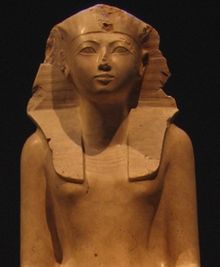Winner of the Fall 2016 StMU History Media Award for
Best Introductory Paragraph
Article with the Best Title
Queen B said it best when she sang the infamous line, “Who run the world? Girls.”1 When looking back to history, men are seen as better and treated better than women. A long time ago, in ancient Egypt, women of the royal family served as guides to young male rulers. But there was one unconventional case where a woman defied the odds and obtained the role of pharaoh.

Queen Hatshepsut was the oldest daughter of Thutmose and his Great Royal Wife, Queen Ahmose. Thutmose, like most males who held power during those times, had another wife with whom he had a son. His name was Thutmose II; when he was at the age of eight and Hatshepsut was thirteen, they were wed, despite the fact of their shared blood line. When their father passed, Thutmose II assumed the position of pharaoh. While he was pharaoh, they birthed a daughter, but every male in power needs a male heir. Since she was unable to produce a son, he and a minor wife, Iris, conceived a son who became Thutmose III. Thutmose II and Hatshepsut reigned in Egypt until his death. The next male in line was Thutmose III, but Hatshepsut’s step child was too young to fulfill the position of pharaoh, so she ruled in his stead. On that note, even when he did become old enough to rule, she refused to turn over the power to him, and she remained in power. That is when she began her transition from Queen Hatshepsut to Pharaoh Hatshepsut.2

The Queen herself had a headdress made that included a beard and some male characteristics.3 She did not go out of her way to keep her gender a secret, for she did include feminine touches to her attire. Masculinity of course was respected more and was associated with power, which is why she sometimes took on such characteristics. Despite being a female ruler, at that time (and still today) people would not expect such a flourishing reign. Beginning in 1473 B.C.E. and ending in 1458 B.C.E., under her control wealth was accumulated. When it came to the protection of Egypt, she engaged in successful warfare against her invaders. She also had an extensive building program in which a temple of devotion to their sun god, Amun, was erected. Prosperity and wealth also came about because she sent ships on expeditions to foreign lands to obtain riches. These included ivory, ebony, gold, and trees. Now, why would they bring back trees? Whenever they had temple ceremonies, trees would be burned by the tons for fragrant incense.4
All good things must come to an end, and this particular ending is death. After she died, successors attempted to erase the fact that a female had become pharaoh.5 Even with this attempt to erase history, she is still known as a successful pharaoh to this day. She brought about protection, prosperity, and plenitude during her time as king. She did not serve as a guide to a young male pharaoh, but she showed how one must rule during her reign.
- Beyoncé, “Run the World (Girls),” in 4, Columbia Records, 2011. ↵
- Ann Macy Roth, “Models of Authority: Hatshepsut’s Predecessors in Power,” in Hatshepsut: From Queen to Pharaoh, ed. Catharine H. Roehrig, Renee Dreyfus, and Cathleen A. Keller (New York: Metropolitan Museum of Art, 2005), 10. ↵
- Roth, “Models of Authority: Hatshepsut’s Predecessors in Power,” 10. ↵
- Rupert Matthews, DK Eyewitness Books: Explorer (DK Publishing, 2012), 8. ↵
- Angela Murock Hussein, “Legacy of a Female Pharaoh,” Calliope 19, no. 1 (September 2008): 48. ↵



85 comments
Ysenia Rodriguez
She is definitely “the man.” As the first female pharaoh, Queen Hatshepsut lead Egypt without skipping a beat and defied many standards of pharaohs. Queen Hatshepsut was able to lead after losing her husband/step sibling and it’s a shame that her predecessors tried to erase her legacy. She did nothing to cause turmoil within Egypt and even attempted to showcase masculine features in her headdress. Despite their efforts, Queen Hatshepsut’s legacy remains strong throughout history.
Eric Ortega Rodriguez
Excellent article and title. I found this article fascinating because I have heard about Queen Hatshepsut but never quite looked into it. I find it crazy that although this was thousands of years ago, the idea of a man being superior to women has always been around. Queen Hatshepsut, however, made it clear that women can achieve anything a man can do. I also found it fascinating how she would put on a beard in order to have the appearance of being more dominant in the public. Overall, this was a very interesting article to read, and once again, a great title!
Ariana Melendez
I recently learned about Queen Hatshepsut and her reign in Egypt. I believe her work was extraordinary, especially since she defied so many odds and in her time. This article does a good job of giving plenty of information while keeping the read short and compact. It makes Hatshepsut’s history easy to understand. It is a shame, however, that the other pharaohs attempted to erase her from history when she contributed to the thriving of the kingdom.
Annissa Noblejas
The marriage of blood relatives was a frequent royal Egyptian practice. The reign of Queen Hatshepsut was marked by prosperity and wealth. History has rarely been kind to female figures in power, but she managed to not only obtain the thrown but keep it throughout her lifetime. My guess is that she fostered friendships within the higher ranks of Egyptian society and priesthood. Despite a widely successful reign, future rulers attempted to erase all trace of her.
Christopher Hohman
Nice article. I really loved the title too. It is very cool that a woman ruled in ancient Egypt at a time when only men could hold positions of power. I like the fact that although she had a headdress that made her look more masculine, and I also love the beard that’s hilarious she never lost touch with her feminine side. It is sad that those who came after her attempted to erase her from their history. When I read about historical figures I usually find that women are better at ruling then men.
Steven Hale
It sounds like there were not any areas where Queen Hatshepsut could have done better. We typically associate rulers with one aspect of leadership such as winning battles or building a prosperous economy, but she did both. I was disappointed to read that her successors tried to erase her legacy. I suppose some were worried that Queen Hatshepsut’s success would prompt other women in the royal family to seize power.
Yadira Chavez
It is so interesting how our oldest ancestors, the hunters and gatherers, were egalitarian. Then as time went on, man developed a sense of entitlement and women lost the respect they once had, and even now we suffer the consequences of that. Pharaoh Hatshepsut was a woman who broke the glass ceiling placed above her and we have to thank her for that! This article is short but sweet, in that it is always nice to be reminded of girl power!
Rebecca Campos
Any article that begins with a Beyoncé quote is bound to be good. I had never really known much about Queen Hatshepsut before reading this. She is an early example of the type of woman young ladies should aspire to be in the sense that she rose to the occasion and wasn’t afraid to stand out in this male dominate position. The author did a brilliant job presenting this strong female figure in such concise and clear article.
Regina De La Parra
I enjoyed reading this article a lot because even though it is small, it explains a lot of very important information about this famous queen. It was very interesting for me to read this article because even though I knew her long before, I did not know a lot of things. For example, how she sometimes used masculine traits as a sign of power. This is a great article. Good job Soki!
Jasmine Jaramillo
Reading about a female pharaoh was very interesting. I think it was cool that Queen Hatshepsut became queen at a young age and was able to keep her position for a long time. I thought it was also cool how she refused to give up her position to the throne when it was time for Thutmose III to become king. I feel sad that history of her great work as a pharaoh wanted to be removed since she was a female. Queen Hatshepsut brought wealth and prosperity to her land which is very inspiring and makes me proud.